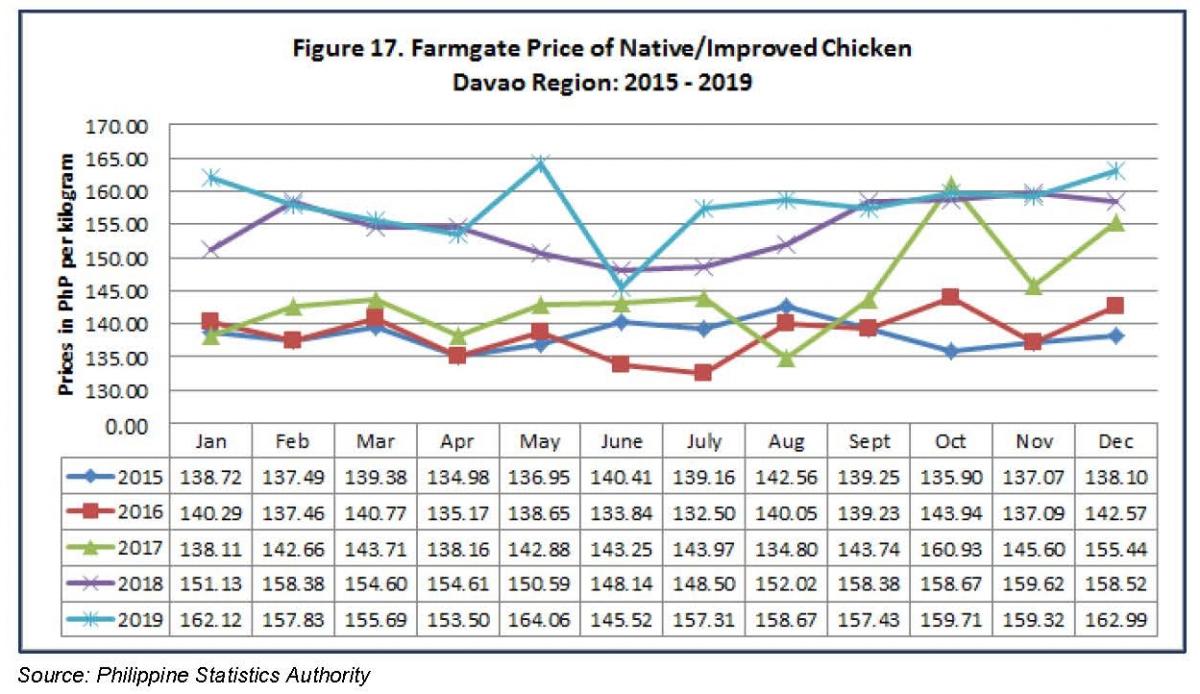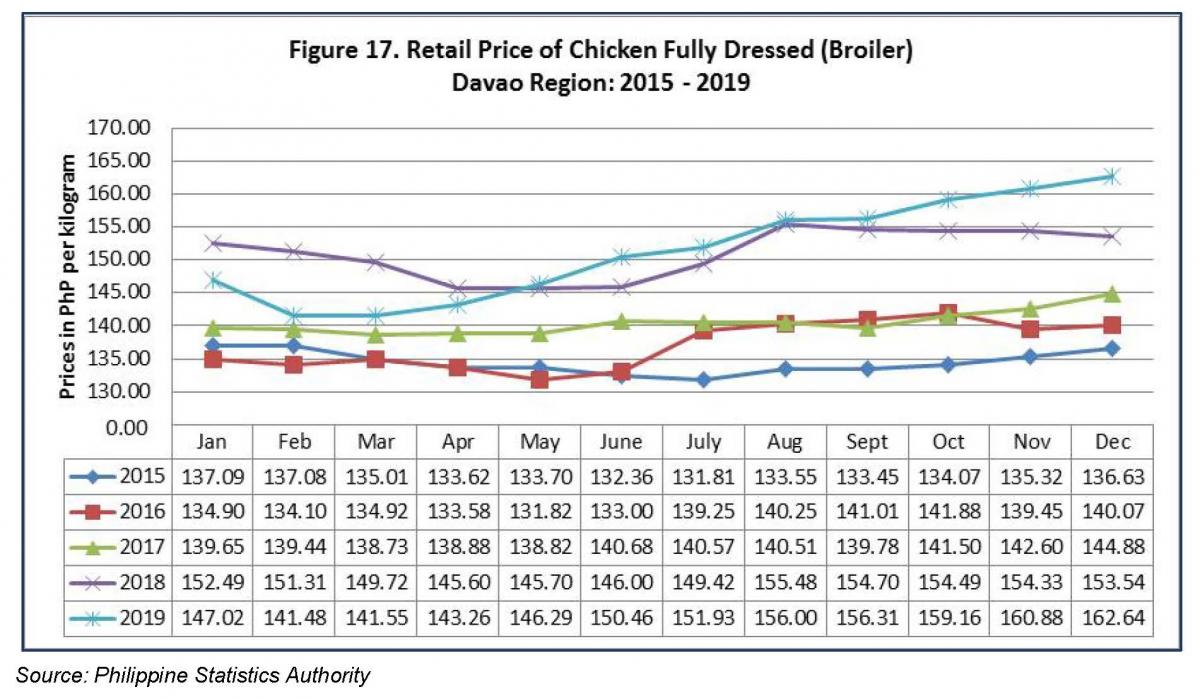 VOLUME OF PRODUCTION
VOLUME OF PRODUCTION
Chicken production expanded at an annual average of 3.53 percent from 2015-2019 with its highest annual growth of 7.54 percent in 2015. In terms of levels, the highest production was recorded in 2019 with 81,090 metric tons (liveweight). Meanwhile, its by-product, chicken egg, registered its highest growth rate of 21.16 percent in 2019. During the five year period, production registered an equivalent of 5,528 metric tons increase from the previous year level.

Duck production showed a decreasing trend for five consecutive years from 2015-2019. The highest annual rate of decrease for the period was observed in 2019. In this year, duck production declined by 5.96 percent. In terms of levels, the highest production was noted in 2017 with 1,154 metric tons. Volume of duck egg grew at an average annual rate of 6.36 percent. During the five-year period, production peaked in 2018 but tapered off to 1,351 metric tons in 2019.
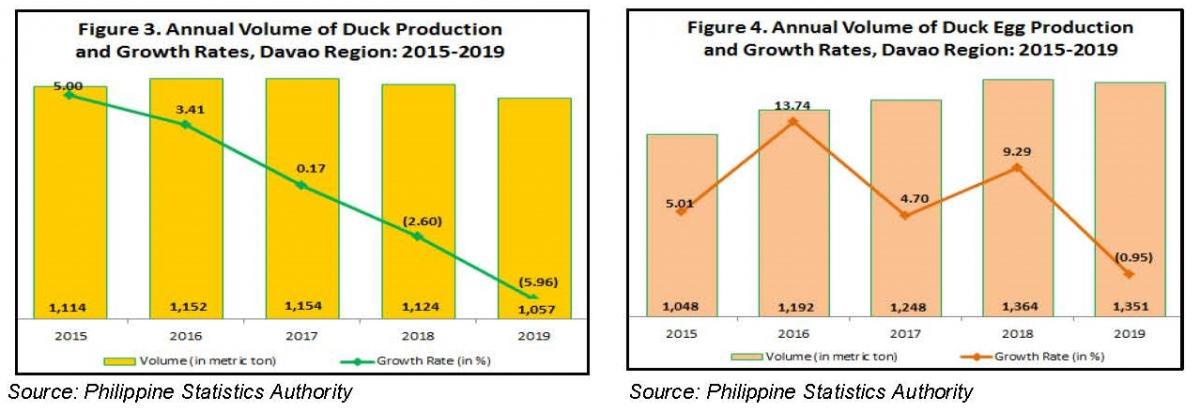
Davao Region’s chicken production at 81,090 metric tons ranked seventh among the sixteen producing regions in the country.
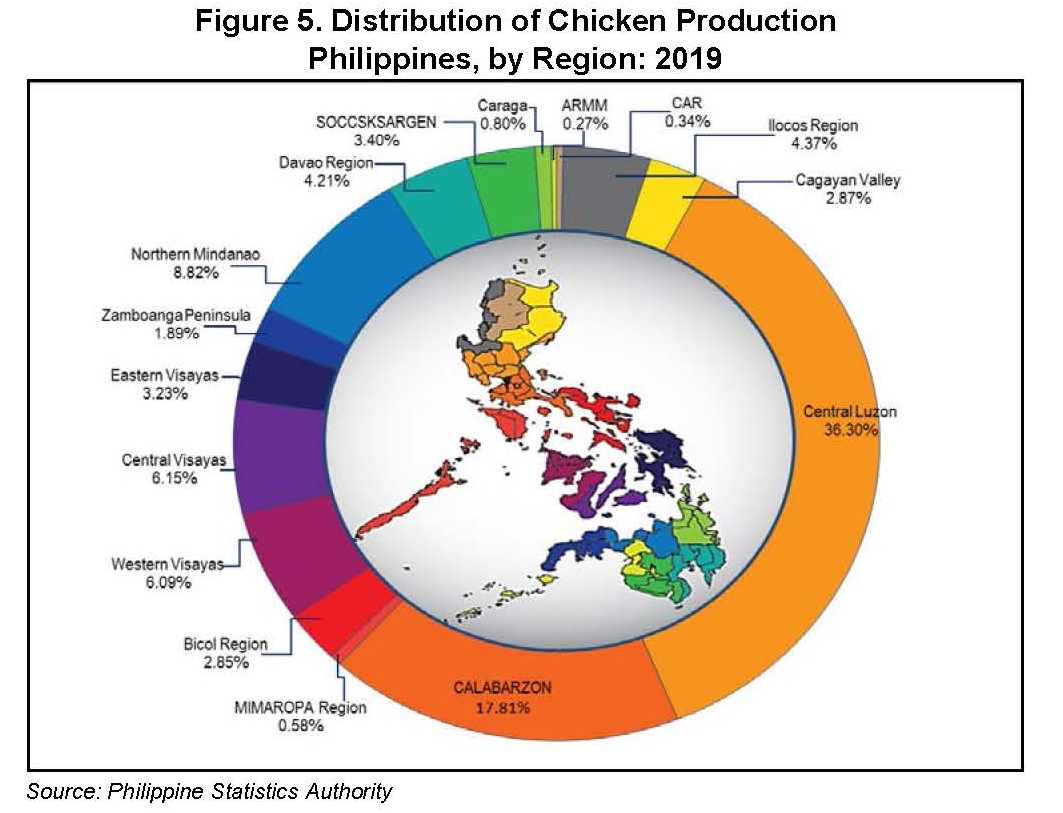
Chicken production in Region XI got 4.21 percent share to the country’s 1.93 million metric tons output. Among the regions in Mindanao, Davao Region ranked second to Northern Mindanao’s 170,021 metric tons output or 8.82 percent share to the national production. Central Luzon got the top spot with 699,655 metric tons or 36.30 percent share.
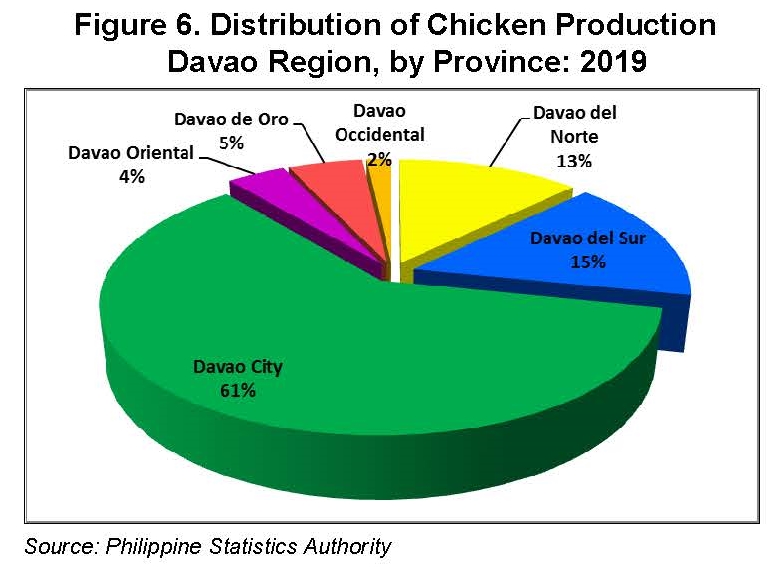
In 2019, 61 percent of Davao Region’s chicken production was supplied by Davao City at 49,263 metric tons. Meanwhile, being the 81st and newest province in the Philippines, Davao Occidental shared the least to the total chicken production in Region XI with only 1,417 metric tons.
Chicken egg production in Davao Region ranked sixth among the sixteen producing regions in the country.
Davao Region got 5.43 percent to the country’s 583,234 metric tons chicken egg production. Among the six regions in Mindanao, Region XI placed only second to Northern Mindanao 8.44 percent share. CALABARZON contributed to the bulk of the production with an equivalent of 174,939 metric tons.
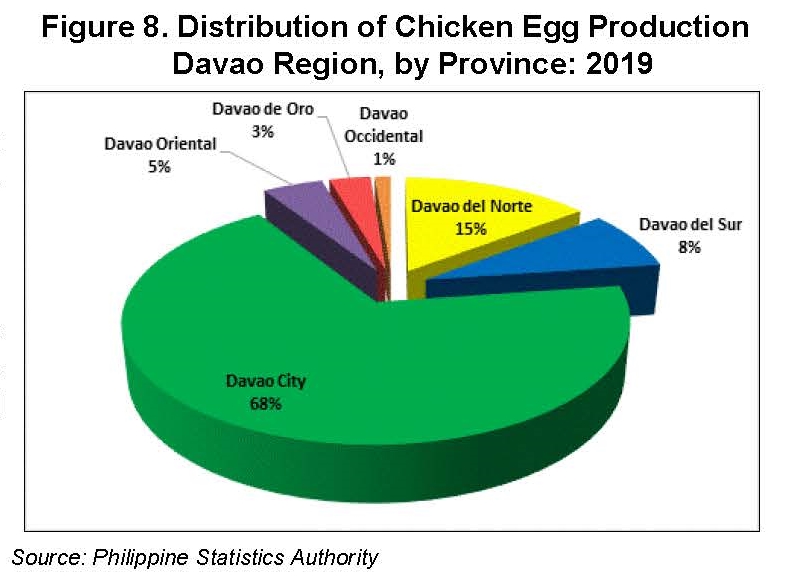
Davao City contributed a significant 68 percent share to Davao Region’s 31,651 metric tons chicken egg output in 2019. Davao del Norte was the second top producing province reaching 4,632 metric tons. Securing the third top contributing province is Davao del Sur at 2,580 metric tons.
Duck production in Region XI accounted for 3.51 percent share to the country’s 30,103 metric tons total production.
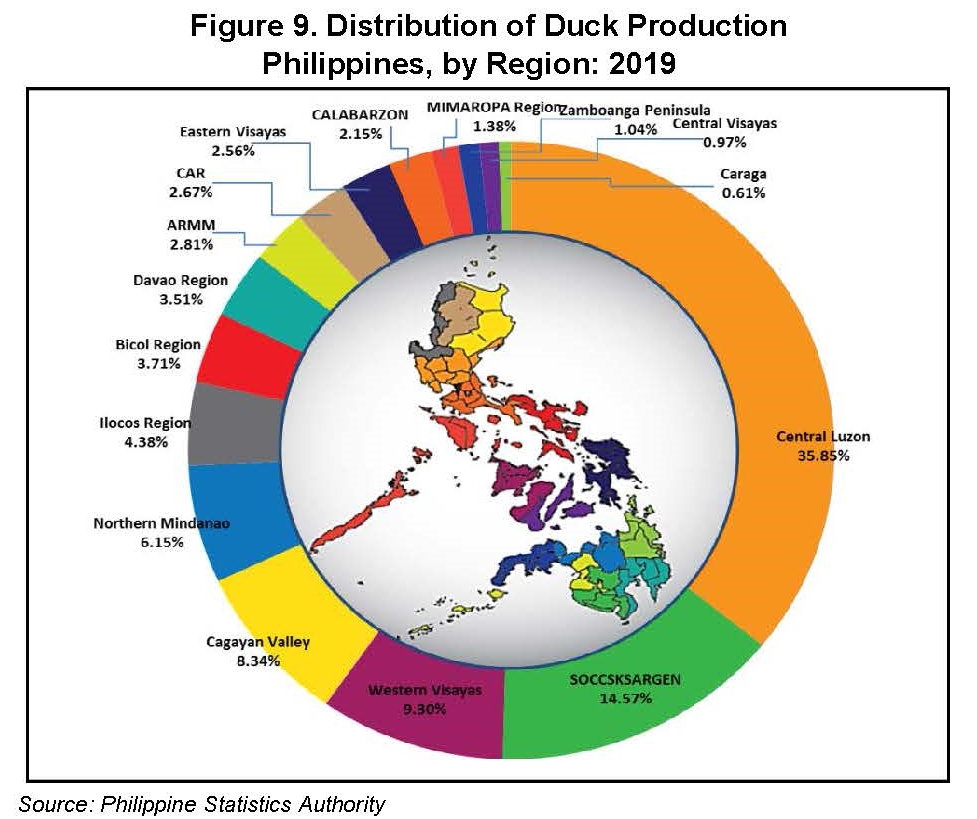
Davao Region ranked eighth among the sixteen duck producing regions in the country. Four among the six regions in Mindanao were in fact included in the top 10 duck producing regions. SOCCSKSARGEN topped with 4,385 metric tons (MT), followed by Northern Mindanao (1,850 MT), Davao Region (1,057 MT) and ARMM (847 MT).
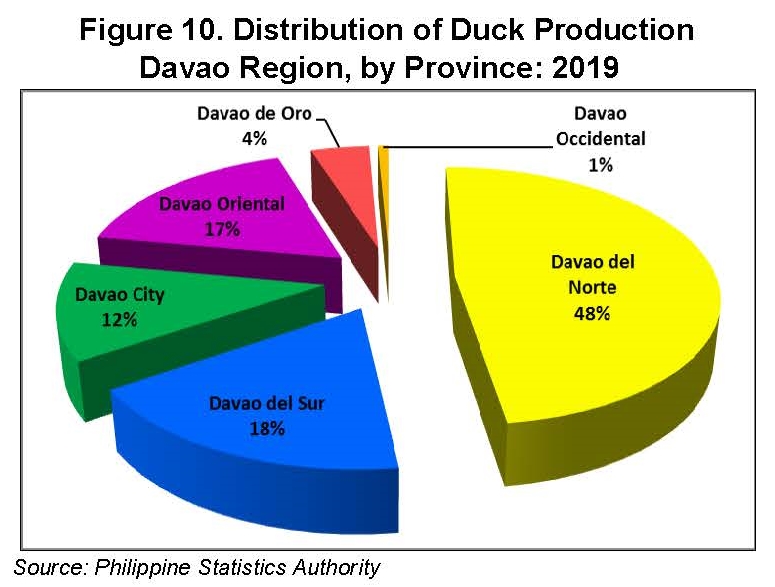
The province of Davao del Norte was the region’s top duck producer with 48 percent share or an equivalent of 506 MT. The second major producer was Davao del Sur with 189 MT. Closing the top three is the province of Davao Oriental which contributed 181 MT.
Davao Region’s duck egg production contributed 2.73 percent share to the country’s 49,569 metric tons overall output.

Davao Region contributed 1,351 metric tons (MT) to the country’s aggregate production. While Central Luzon was consistently the top duck egg producing region, Davao Region also consistently ranked in the top 9 from 2016 to 2019 (except in 2017 where it ranked tenth). Among regions in Mindanao, Northern Mindanao contributed most with 4,451 MT. This was followed by SOCCSKSARGEN with 3,536 MT, Zamboanga Peninsula with 1,847 MT. Davao Region, ARMM and Caraga contributed 1,351 MT, 915 MT and 582 MT respectively.
Since 2010, duck egg production remained highest in Davao del Norte among the five provinces and one Highly Urbanized City (HUC) in Davao Region. In 2019, its output registered at 771 MT or a decline of 3.75 percent from its 2018 level.
CHICKEN INVENTORY
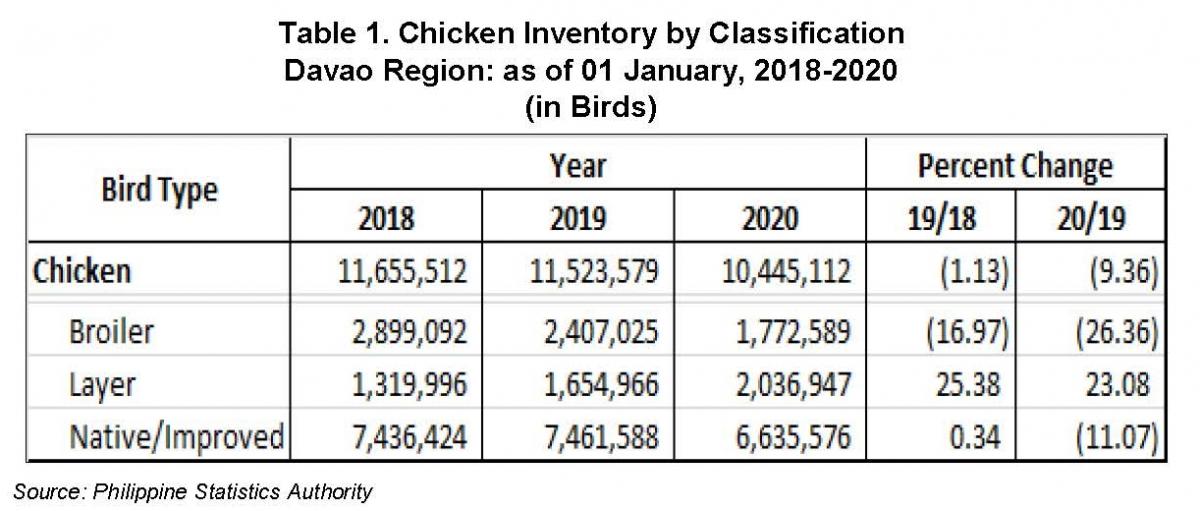
During the period of 01 January since 2018, a consistent reduction of stocks was observed in Davao Region’s total chicken population.
Chicken inventory in Davao Region as of 01 January 2019 diminished by 1.13 percent compared to same period in 2018.
As of January 1, 2020, inventory for all types of chicken was noted at 10.45 million birds or a decline of 9.36 percent over last year’s same period stock. This was brought about by the decrease in stocks of broiler and native/improved chicken.
- Chicken inventory is composed of broiler, layer and native/improved population.
- Broiler chicken inventory dropped by 26.36 percent or a difference of 634,436 birds in contrast to 01 January 2018 count.
- Layer chicken inventory as of 01 January 2020 was at 2.04 million birds or an increase of 23.08 percent in comparison with the inventory of same period of last year.
- Every period 01 January from 2018 to 2020, native/improved chicken was the most dominant type of chicken in Davao Region. Its stocks at 6.64 million birds reduced by 11.07 percent.
The country’s total chicken inventory as of 01 January 2020 was at 178.26 million birds. Region XI accounted for 5.86 percent share and ranked 7th among the sixteen top producing regions.
TOP PRODUCING DAVAO REGIONS PROVINCES
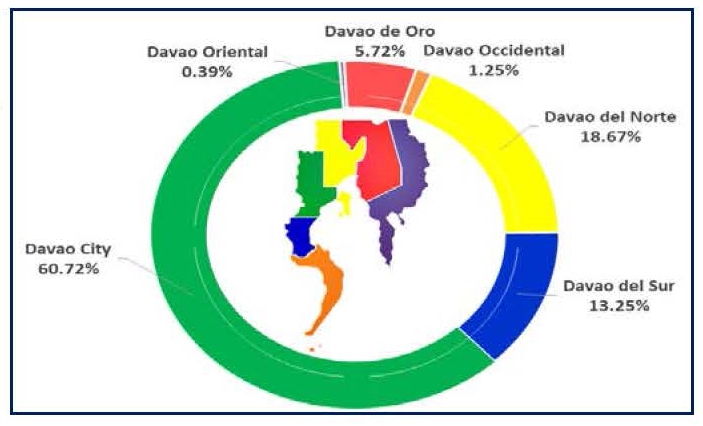
Chicken Broiler population was around 1.77 million birds. Davao City had the highest chicken inventory with a total share of 60.72 percent. Together with Davao del Norte and Davao del Sur, these three (3) provinces contributed 92.64 percent to the Region's total broiler inventory.
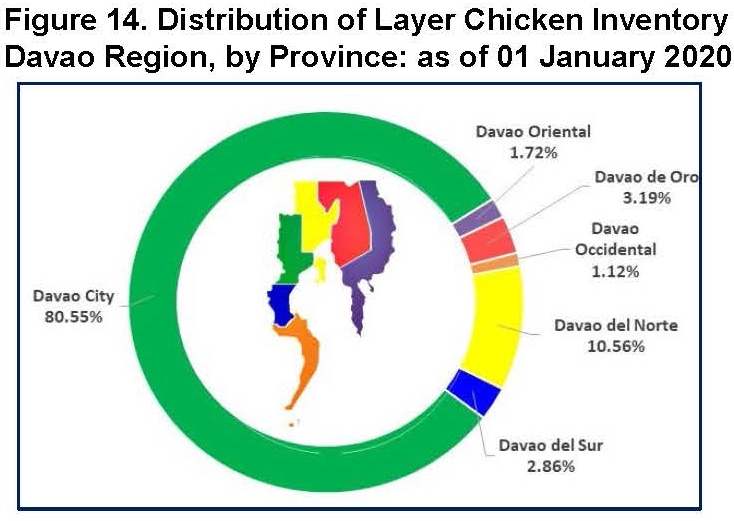
Davao Region’s inventory of Layer chicken was at 2.04 million birds. In terms of levels, Davao City had the highest inventory at 1,640,749 birds.

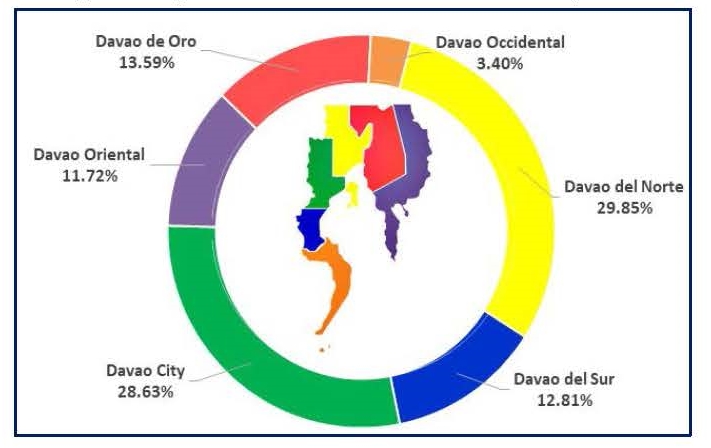
The total native/improved chicken inventory was at 6.64 million birds. In terms of level, the province with the highest count was Davao del Norte at 1.98 million birds. This was followed by Davao City at 1.90 million birds and Davao de Oro at 0.90 million birds.
DUCK INVENTORY
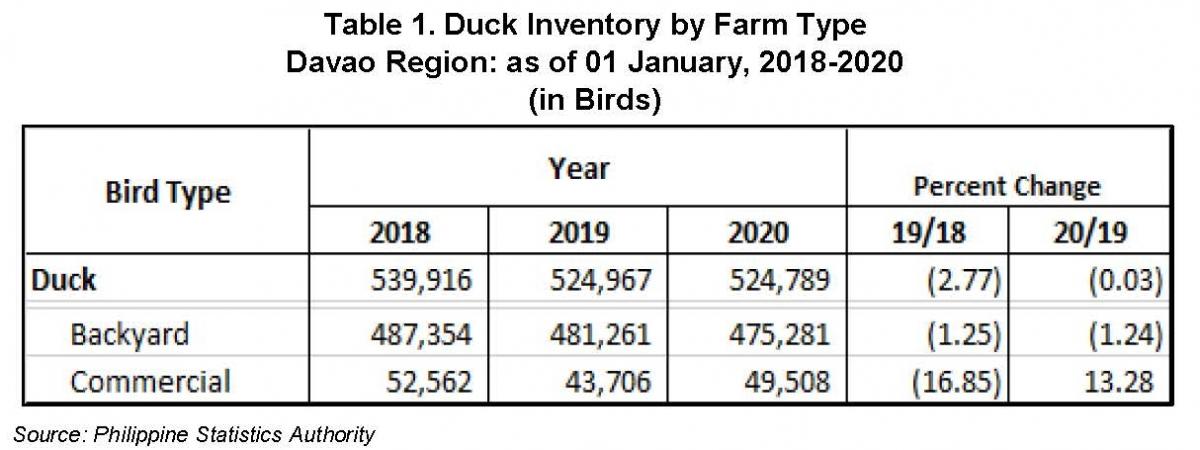
From 2018 to 2020, a decreasing trend can be observed in Davao Region’s duck population. In the three-year period of 01 January, the highest inventory was noted in 2018.
As of 01 January 2019, Davao Region’s duck inventory at 5.25 thousand birds, declined by 2.77 percent in contrast with the same period in 2018.
As of 01 January 2020, duck inventory minimally dropped by 0.03 percent. This can be attributed to the consistent reduction of stocks in backyard farms.
- Backyard duck farm continued to account for the largest share of 90.57 percent in the region’s total duck inventory. The remaining 9.43 percent came from commercial farms.
The province of Davao del Norte sustained 46.18 percent of Davao Region’s backyard farm population.
- Inventory in duck commercial farms exhibited a downward trend from 2018 to 2019. In 2020, an increase of 13.28 percent was noted or an equivalent of 5,802 birds compared to same period in 2019.
Only three Davao Region provinces have duck commercial farms.
In terms of distribution, commercial duck inventory was highest in Davao del Norte at 54.62 percent, Davao de Oro at 41.16 percent and Davao del Sur at 4.22 percent.
The country’s total duck inventory as of 01 January 2020 recorded at 11.79 million birds. Region XI accounted for 4.45 percent share and ranked 6th among the sixteen top producing regions.
VOLUME OF BIRDS DRESSED IN DRESSING PLANTS
In 2019, chicken dressed in poultry dressing plants in Davao Region dropped by 12.85 percent.
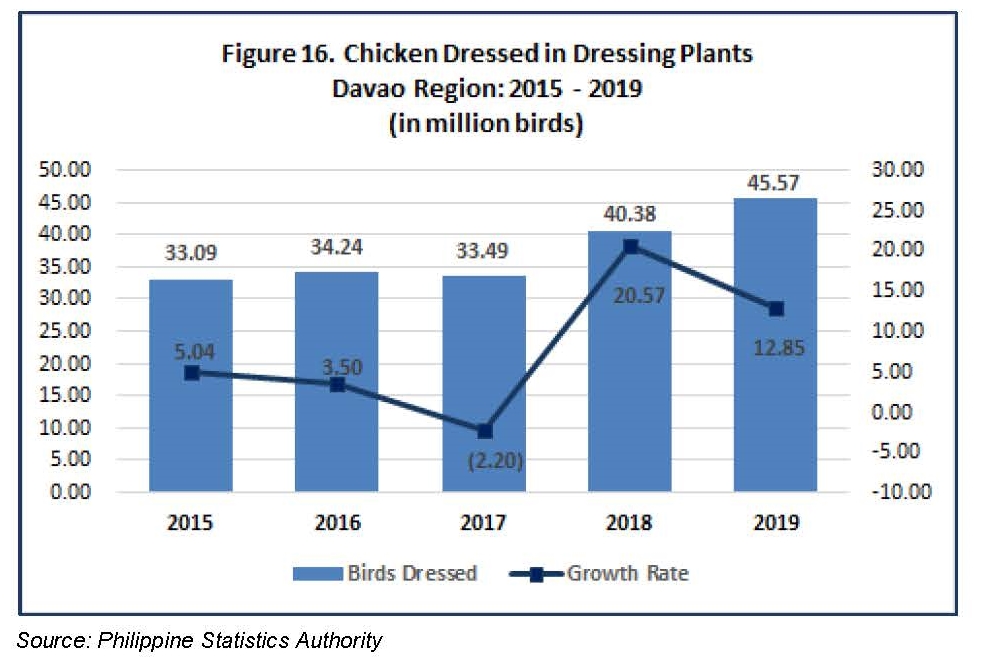
During the period 2015-2019, number of chickens dressed in Slaughterhouses and Poultry Dressing Plants (PDPs) increased from 33,085,748 birds in 2015 to 45,572,611 birds in 2019.
On a year-to-year comparison, chicken dressed in PDPs in Davao Region peaked in 2018 at 20.57 percent. In 2019, it also accelerated but at a slower growth rate of 12.85 percent.
Davao City, Davao del Sur and Davao del Norte are three provinces in Davao Region with existing PDPs. Among these, Davao City registered the largest share of 87.40 percent of the total dressed chicken. It was followed by Davao del Sur and Davao del Norte with a corresponding contribution of 12.51 percent and 0.09 percent, respectively.
FARMGATE PRICE OF NATIVE/IMPROVED CHICKEN
In 2019, the highest farmgate price was recorded in the month of May at 164.06 pesos per kilogram, an increase by 8.94 percent from the 2018 prices while the lowest price was noticed in the month of June at 145.52 pesos per kilogram, a drop of 1.77 percent compared to 2018 prices.
The highest farmgate prices every January, May and December were all noted in the year 2019.
In 2015-2019, it can be observed that farmgate prices tend to increase every December except in the year 2018.
During the five-year reference period, the highest price was documented in May 2019 while the least price was monitored in July 2016.
RETAIL PRICE OF CHICKEN FULLY DRESSED (BROILER)
The annual average retail price of fully dressed broiler chicken in Davao Region grew by 0.06 percent, that is from Php 151.30 in 2018 to Php 151.39 in 2019.
From April until December 2019, the retail prices of fully dressed broiler chicken in Davao Region exhibited an increasing trend.
The highest retail price recorded every January was noted in the year 2018. It was even higher by Php 5.47 compared to January 2019 retail price.
In 2015-2019, it can be observed that farmgate prices tend to increase every December except in the year 2018. During the five-year reference period, the highest price was documented in December 2019 while the least price was monitored in July 2015.
APPROVED FOR RELEASED:
PEPITO D. AMOYEN
(Chief Statistical Specialist)
OIC-Regional Director
 VOLUME OF PRODUCTION
VOLUME OF PRODUCTION

















